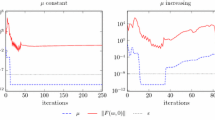Abstract
Several recent algorithms for solving nonlinear programming problems with equality constraints have made use of an augmented “penalty” Lagrangian function, where terms involving squares of the constraint functions are added to the ordinary Lagrangian. In this paper, the corresponding penalty Lagrangian for problems with inequality constraints is described, and its relationship with the theory of duality is examined. In the convex case, the modified dual problem consists of maximizing a differentiable concave function (indirectly defined) subject to no constraints at all. It is shown that any maximizing sequence for the dual can be made to yield, in a general way, an asymptotically minimizing sequence for the primal which typically converges at least as rapidly.
Similar content being viewed by others
References
K.J. Arrow and R.M. Solow, “Gradient methods for constrained maxima, with weakened assumptions”, in:Studies in linear and nonlinear programming, Eds. K. Arrow, L. Hurwicz and H. Uzawa (Stanford Univ. Press, Stanford, Calif., 1958).
K.J. Arrow, F.J. Gould and S.M. Howe, “A general saddle point result for constrained optimization”, Institute of Statistics Mimeo Series No. 774, Dept. of Statistics, Univ. of North Carolina, Chapel Hill, N.C., (1971).
A.V. Fiacco and G.P. McCormick,Nonlinear Programming: Sequential Unconstrained Minimization Techniques (Wiley, New York, 1968).
R. Fletcher, “A class of methods for nonlinear programming with termination and convergence properties”, in:Integer and nonlinear programming, Ed. J. Abadie (North-Holland, Amsterdam, 1970) pp. 157–175.
R. Fletcher and Shirley A. Lill, “A class of methods for nonlinear programming, II: Computational experience”, in:Nonlinear programming, Eds. J.B. Rosen, O.L. Mangasarian and K. Ritter (Academic Press, New York, 1971) pp. 67–92.
E.G. Golshtein,The Theory of Duality in Mathematical Programming and its Applications, Nauka (1971) (in Russian).
E.G. Golshtein,Theory of Convex Programming, AMS Translation Series (1972).
P.C. Haarhoff and J.D. Buys, “A new method for the optimization of a nonlinear function subject to nonlinear constraints”,Computer Journal 13 (1970) 178–184.
M.R. Hestenes, “Multiplier and gradient methods”, in:Computing methods in optimization problems — 2, Eds. L.A. Zadeh, L.W. Neustadt, A.V. Balakrishnan (Academic Press, New York, 1969) pp. 143–164.
M.R. Hestenes, “Multiplier and gradient methods”,Journal of Optimization Theory and Applications 4 (1969) 303–320.
J.L. Joly and P.-J. Laurent, “Stability and duality in convex minimization problems”,Revue Française d'Informatique et de Recherche Opérationelle R-2 (1971) 3–42.
P.J. Laurent,Approximation et Optimisation (Hermann, Paris, 1972).
A. Miele, E.E. Cragg, R.R. Iver and A.V. Levy, “Use of the augmented penalty function in mathematical programming problems, part I”,Journal of Optimization Theory and Applications 8 (1971) 115–130.
A. Miele, E.E. Cragg and A.V. Levy, “Use of the augmented penalty function in mathematical programming problems”, part II,Journal of Optimization Theory and Applications 8 (1971) 131–153.
A. Miele, P.E. Moseley and E.E. Cragg, “A modification of the method of multipliers for mathematical programming problems”, in:Techniques of optimization, Ed. A.V. Balakrishnan (Academic Press, New York, 1972) pp. 247–260.
A. Miele, P.E. Moseley, A.V. Levy and G.M. Coggins, “On the method of multipliers for mathematical programming problems”,Journal of Optimization Theory and Applications 10 (1972) 1–33.
M.J.D. Powell, “A method for nonlinear constraints in minimization problems”, in:Optimization, Ed. R. Fletcher (Academic Press, New York, 1969) pp. 283–298.
R.T. Rockafellar, “Convex functions and duality in optimization problems and dynamics”, in:Mathematical systems theory and economics, I, Eds. H.W. Kuhn and G.P. Szegö (Springer, Berlin, 1969) pp. 117–141.
R.T. Rockafellar,Convex Analysis (Princeton Univ. Press, Princeton, N.J., 1970).
R.T. Rockafellar, “Ordinary convex programs without a duality gap”,Journal of Optimization Theory and Applications 7 (1971) 143–148.
R.T. Rockafellar, “New applications of duality in convex programming”, written version of talk presented at the Seventh International Symposium on Mathematical Programming, The Hague, 1970, and elsewhere; in:Proceedings of the fourth conference on probability theory, Brasov, Romania, 1971 (Editura Academici Republicii Socialiste Romania, Bucharest, 1973) pp. 73–81.
R.T. Rockafellar, “The multiplier method of Hestenes and Powell applied to convex programming”,Journal of Optimization Theory and Applications 12 (6) (1973).
Author information
Authors and Affiliations
Additional information
Supported in part by the Air Force Office of Scientific Research under grant AF-AFOSR-72-2269.
Rights and permissions
About this article
Cite this article
Rockafellar, R.T. A dual approach to solving nonlinear programming problems by unconstrained optimization. Mathematical Programming 5, 354–373 (1973). https://doi.org/10.1007/BF01580138
Received:
Revised:
Issue Date:
DOI: https://doi.org/10.1007/BF01580138



